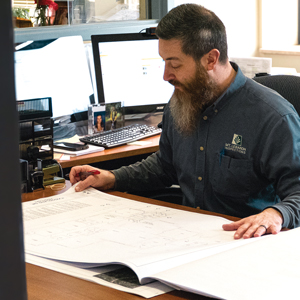teardowns: starting from scratch
Joe and Melisa Cortes bought their 1950s-era Altadena Drive house in 2006 and enjoyed living there, but once they had three kids, they felt stuffed into the 1,100-square-foot home, with only one bathroom—especially with two daughters. They looked at houses and land inside and outside of Mt. Lebanon. It helped that for the last 24 years, Joe Cortes has been a homebuilder who also constructs additions. He knew what it would take to rehab an older home or start fresh on a new lot.
But lots were expensive, with some going for as much as $150,000 to $225,000 just for the land, with most availability outside of Mt. Lebanon. And they already had paid down their mortgage significantly for more than a decade. Besides, they liked their neighborhood, especially with Markham School just behind their home.
“It just made sense to tear it down,” he says. The family started with Joe’s drawings, then brought on an architect. Joe’s industry contacts made it easy (he owns Cortes Builders Inc. with his cousins, Matt and John Cortes). Within four hours on demolition day, the house was down.

By December 2016, less than a year after beginning the project, the Cortes family was living in a 3,100-square-foot Colonial revival on the same spot, with five bedrooms and 3-1/2 bathrooms, tons of storage, 9-foot ceilings in the basement, a master bath with a double vanity and a two-car garage.
Demolishing a house is not a frequent choice in Mt. Lebanon, where most homeowners prefer to renovate, but it is done. According to municipal inspections department records, 20 houses have been demolished since 2002, not counting those eliminated to make way for other development, such as the Academy Avenue parking lot, or the townhouses at 400 and 770 Washington Road.
Contrary to rumors you may have heard, Mt. Lebanon does not have any regulations to prevent complete demolition, even if the house is one of the 4,400 contributing structures within Mt. Lebanon’s Historic District.
“You can tear down any house that you own and make an application to raze it,” says Chief Inspector Joe Berkley. “To rebuild you have to follow rules for infill development.”
Therein lies the difference for some homeowners. The building codes for renovation and infill are the same, but with infill, additional zoning requirements apply. The infill regulations were strengthened the last time the zoning ordinance was updated in 2011, in part because of recommendations from the historic preservation board.

Those stricter infill rules exist to make sure new construction doesn’t dwarf the houses around it or allow a structure to totally change the character of the neighborhood, which in turn could lower property values. Mandatory regulations put limits on the square footage of the new façade—it can’t be larger than 135 percent of the average square footage of the facades of other houses within 200 feet. A floor area ratio also says the house can’t be more than 145 percent of the average floor area of those houses within 200 feet.
The homeowners also must choose from at least three optional categories to make the house fit into the neighborhood: roof style, garage orientation, front porch, exterior building materials, pattern and scale of window and door openings.
For the Cortes family, those rules meant it was easier for them to build a taller home than a wider home on their small lot. But context was top of mind too.
“I thought it was important to try to make it blend.”
– Joe Cortes.
That’s an important concept, says Yvette Yescas, chair of the Mt. Lebanon Historic Preservation Board, which advises the municipal Commission on historic preservation and serves as a resource for people who are renovating or building homes. “So many people have done a good job staying in context,” Yescas says.
“Keeping historic character in a neighborhood does a lot for creating a sense of place in a community; it gives the community a personality. When you do not take that into consideration in a rebuild, you chip away at what makes your neighborhood special.”
Fair enough. But what if you don’t know much about what architectural characteristics best suit Tudor revivals or what sorts of windows belong on a Colonial? Yescas points to several places you can go for help.
First, a group of residents of Virginia Manor, asking for help with collecting resources for those doing major work on homes in that community, were behind the compilation of voluntary design guidelines for that community. The document, while not binding in any way, provides information on several types of architectural styles found throughout Mt. Lebanon, and much of what is included is applicable to houses in other subdivisions. That guide is available online: at www.mtlebanon.org/documentcenter/view/11202.
Yescas also recommends the Secretary of the Interior’s Standards for Rehabilitation, which helps with building materials and has ideas for keeping your home in good shape. www.nps.gov/tps/standards/rehabilitation/rehab/stand.htm

Mt. Lebanon’s historic preservation board, which includes, architects, preservationists and real estate professionals, can suggest how a new house can fit into an old neighborhood. www.mtlebanon.org/69/Historic-Preservation-Board
After hearing all of this, you may—or may not—be thinking a teardown would work for you.
Cortes had a good experience with his, but again, he does this for a living. Still there are benefits: perhaps first among them, a blank slate and no surprises when contractors open up a 60-year-old wall.
It is an expensive proposition. In this case, his bank would not finance the demolition, and his mortgage had to be paid off before he knocked down the house. That was easy for him because he had lived there for a while and had paid down the mortgage over the years, but for people looking at buying an existing home to immediately demolish, that can be a big check to write, on top of the fact that you may need a 20 percent down payment on the building loan too.
Look at the cost of the house you’re considering building as it relates to others in the neighborhood. Will it be the most expensive? Will you get that money out if you sell? Just because the Cortes family was building to live in the home doesn’t mean they weren’t thinking about eventual resale. About half their decisions were made because they wanted the items but the other half were made in consideration of making the house marketable, such as using neutral colors and hardwood floors.
Cortes also advises that if you’re tearing down a house: “Be cognizant of your neighbors. Be respectful of their space.”
Mt. Lebanon houses are relatively close together, and it can be disconcerting (and dirty!) when bulldozers start knocking things over outside your window. “It can be stressful [for the neighborhood] when it comes down,” Cortes adds, recalling his efforts to be courteous with construction vehicles parked on the street, including moving vehicles many times during leaf pickup to make sure his neighbors’ leaves weren’t blocked from collection.
Perhaps most important, remember that Mt. Lebanon’s inspection department is there to help throughout the process. Speaking with Berkley and Building Inspector Rodney Sarver before beginning a project can prevent problems. Sarver reviews plans and makes frequent inspections during the project with the goal of catching errors before they become expensive to fix in the field.
“There are 16 ways to do something,” Berkley says. “and 14 are probably right.”
Reference: The Zoning Ordinance





